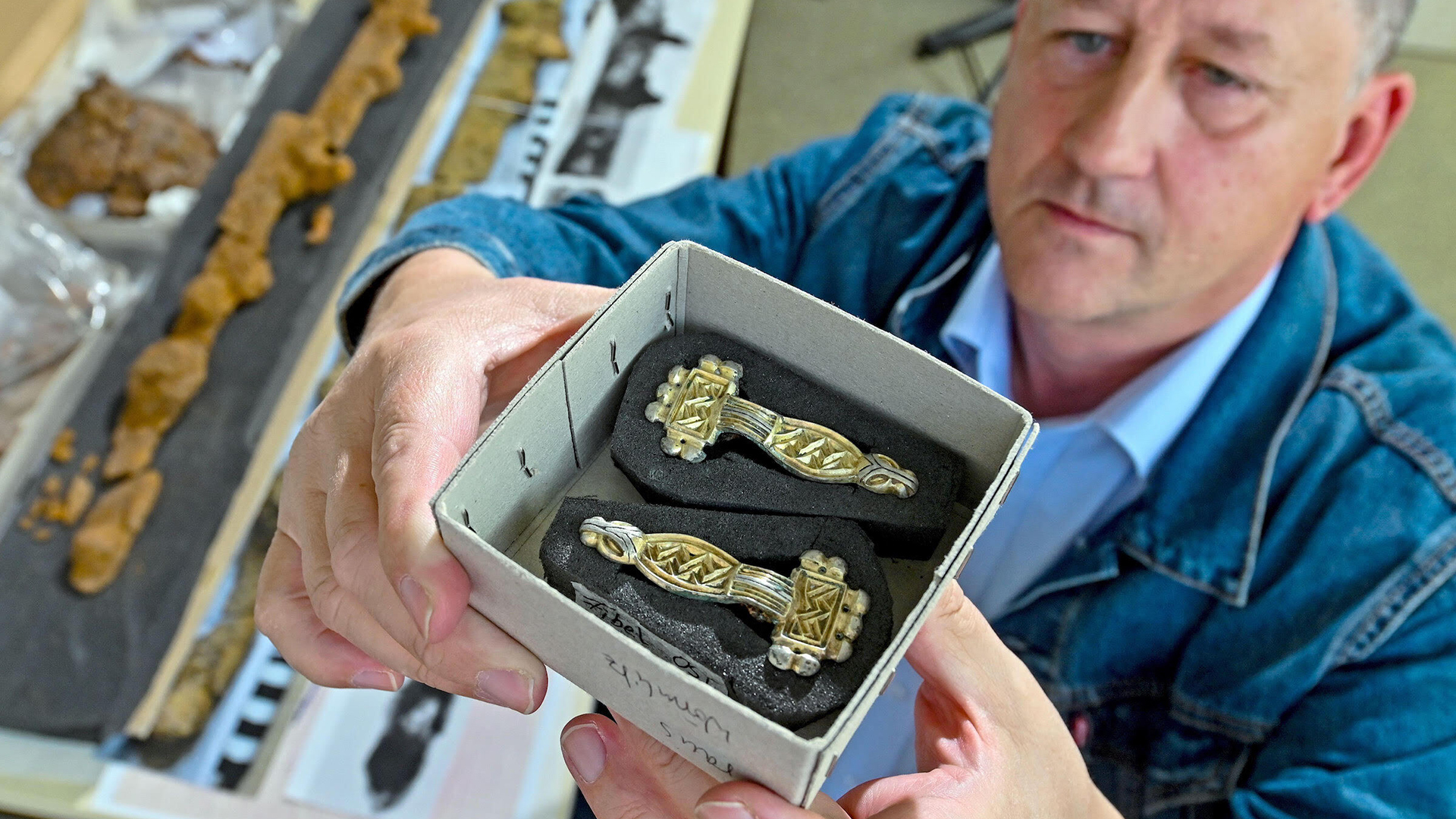Germanic lord buried with a harem of 6? Not quite, but the real story is fascinating.
Newfound medieval cemetery in Germany holds riches.

An early medieval cemetery unearthed in Germany may not contain "a harem for the hereafter," as some news outlets reported; but it's still a remarkable find, likely holding the remains of a wealthy aristocrat and about 80 other people, some buried with riches such as glass bowls, gold jewelry and sharp weapons, according to the State Museum of Prehistory in Halle, Germany.
The individuals buried at the roughly 1,500-year-old aristocratic estate were part of the short-lived Thuringian Kingdom, which lasted for about 80 years before the Franks conquered them in A.D. 531. Before its demise, the kingdom reigned during a tumultuous time known as the Migration Period, when the so-called Barbarian peoples, such as the Huns, Goths and Vandals, gained power as the remains of the Western Roman Empire crumbled.
Some of the Thuringian graves held highly affluent people, at least according to the artifacts buried with them. "In general, the women were equipped with their jewelry (fibulae/brooches, hairpins, necklaces of glass beads) and men with their weapons (sword, lance/spear, shield)," Arnold Muhl, an archaeologist and expert on the Migration and Early Medieval Period at the State Museum of Prehistory, told Live Science in an email.
Related: In Photos: Ancient Roman fort discovered
Archaeologists discovered the cemetery in the summer of 2020, ahead of the construction of a poultry farm in Saxony-Anhalt, in central Germany. The discovery was originally covered in the news as a salacious find — The Times reported that an "Ancient Germanic lord was buried with circle of six women," and the Daily Mail called it "A harem for the hereafter," noting that the six women "may have been killed or sacrificed themselves" upon the Germanic lord's death.
But that's not the case, Muhl said. "Our assumption is that these articles refer to an overinterpretation of an earlier stage of the excavation," he said. What's more, despite reports of a "Germanic lord," there is not thought to be one buried here. "But it is fair to say that the richest of these burials certainly belong to the wealthy owner family of an aristocratic manor," Muhl said.
To understand the excavation, it helps to visualize the site. The cemetery itself, which dates to A.D. 470-540, is a "linear cemetery, in which the graves lie next to each other in rows," Muhl said. The site also has a pit filled with 11 animal burials (four cattle, five horses and two dogs), which was removed from the cemetery in a single earthen block that archaeologists plan to thoroughly excavate soon. Inside that block, archaeologists also found bronze fragments, which may be the remains of a cauldron, "but only future excavation of the block can confirm this assumption," Muhl said.
Get the world’s most fascinating discoveries delivered straight to your inbox.
Other news outlets reported that perhaps the "lord's" ashes were interred in this supposed cauldron. But "cremation was highly unusual in this time period," Muhl said. "Therefore, we do not expect a hidden cremated individual in the block excavation."
Furthermore, early in the excavation, researchers noticed that six graves in one of the cemetery's rows made "a slight curve at a certain distance around the animal burial, as if this row was avoiding an already existing structure" — a burial mound holding an important person, for instance, Muhl said. But subsequent excavations haven't uncovered any such burial.
"Probably this row of six graves was the cause of the speculations [by news outlets] of the widows/concubines, who followed [their] princely husband to death," Muhl said.
This speculation has another problem, Muhl noted: The sex of these six individuals has yet to be determined. So the idea of a harem was really based on no evidence.
But "even without a 'sacrificed harem,' the cemetery of Brücken-Hackpfüffel is a great discovery," Muhl said. "A complete and untouched burial place from the time of the Thuringian Kingdom has not been discovered since 40 years [ago] and offers the exceptional opportunity to accurately investigate everything with the most modern scientific methods." For example, the researchers plan to look at the DNA in these people and at the strontium isotopes (different variations of strontium) in their teeth — a technique that can determine where people were born and grew up, as strontium isotopes in water that people drink as youngsters end up in their chompers.
Related: 12 bizarre medieval trends
These analyses may reveal where some of the females in the cemetery came from, especially those buried with jewelry that may be from other Germanic cultures, such as the Lombards (also spelled Langobards) and Alemanni. Back then, dynastic connections between different tribes and territories were common among nobility, Muhl said.
Other burials also held artifacts from different parts of Europe. For instance, the archaeologists unearthed high-quality glass vessels that were imported from the Frankish Rhineland (what is now western Germany). These vessels "have been preserved completely and are as good as new," Muhl said. "Actually, these glass vessels were prestige objects and are only discovered in the burials of the wealthy elite."
The archaeologists hope to learn more about this Thuringian estate as they analyze the animal-burial block and other artifacts back in their lab, Muhl said.
Originally published on Live Science.

Laura is the managing editor at Live Science. She also runs the archaeology section and the Life's Little Mysteries series. Her work has appeared in The New York Times, Scholastic, Popular Science and Spectrum, a site on autism research. She has won multiple awards from the Society of Professional Journalists and the Washington Newspaper Publishers Association for her reporting at a weekly newspaper near Seattle. Laura holds a bachelor's degree in English literature and psychology from Washington University in St. Louis and a master's degree in science writing from NYU.


